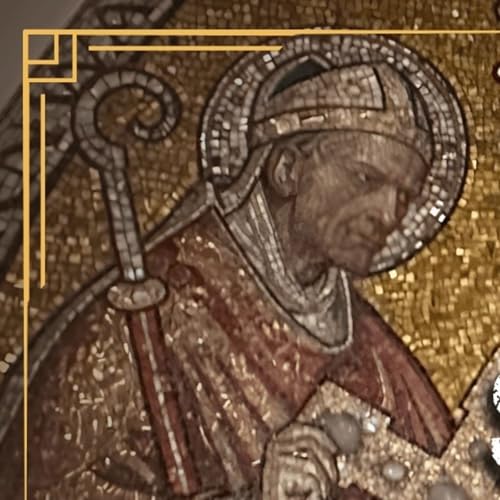
November 20: St. Bernward of Hildesheim, Bishop
カートのアイテムが多すぎます
ご購入は五十タイトルがカートに入っている場合のみです。
カートに追加できませんでした。
しばらく経ってから再度お試しください。
ウィッシュリストに追加できませんでした。
しばらく経ってから再度お試しください。
ほしい物リストの削除に失敗しました。
しばらく経ってから再度お試しください。
ポッドキャストのフォローに失敗しました
ポッドキャストのフォロー解除に失敗しました
-
ナレーター:
-
著者:
このコンテンツについて
c.960–1022
Optional Memorial; Not on Universal Calendar; Liturgical Color: White
Patron saint of goldsmiths & architects
A well-educated and pious bishop sponsors the practical arts
Some doors in the city of Rome draw people in like huge vertical magnets, pulling groups of pilgrims slowly towards them across broad atriums. The dots of laser pointers dance over the doors of the Basilica of St. John Lateran as guides point and explain how these towering doors once swung open onto the Roman Curia, where senators in white togas stood debating matters of empire. The colossal, sober, bronze doors of the 2nd century Pantheon still hang from its jambs. And the large, intricate, wood paneled doors of Santa Sabina date from the 430s! The eyes of today’s saint, Bernward of Hildesheim, gazed up in wonder at these very same sets of doors when he visited Rome in the year 1001. And while he gazed, he also resolved to carry back just a bit of this Roman elegance, this Roman nobility, this Roman weight, to the cold land, to the far land, he had come from.
St. Bernward of Hildesheim lived at the half-way point between us and Jesus Christ. His life spanned mankind’s crossing from the first to the second millennium. Bernward had an impeccable pedigree, with the branches of his noble family tree extending throughout lower Saxony, in today’s northern Germany. His family lineage, fine education, and personal piety opened doors of power and influence to him throughout his life. He was chosen as the tutor to the most important man of his time and place, Otto III, who became the Holy Roman Emperor. And he was appointed bishop of Hildesheim at a young age in 993 and remained in that position, and in that town, until he breathed his last thirty years later.
Bernward lived long before the founding of the great universities of Europe, in an age when monasteries and cathedrals were Europe’s preeminent centers of learning. A cathedral school, in particular, was the equivalent of an elite prep school today. It was as important to a diocese as the cathedral itself. Bernward attended the cathedral school of Hildesheim as a youth long before becoming bishop of the same diocese.
The academic theology done in Europe’s universities starting in the 1200s created a more disciplined and professional guild of theologians but moved theology to a neutral location. In Bernward’s more feudal age, men learned theology in the beating heart of the church, in the red-hot centers of prayer and apostolic activity where the faithful habitually gathered – in cathedrals and monasteries. Bishops, thinkers, and authors baptized babies, said funeral masses, anointed the sick, sang vespers, and led processions while also studying and writing. Their audience was the faithful. Their forum was the pulpit. University-based theology was severed from the great centers of spirituality so familiar to the first millennium. It was more scientific, yes, but also more dry. St. Bernward was a man of the first millennium. His public was not other academics but his happy people. His theology was both intellectual and practical, with church ideas and church life braided tightly together, as they should be.
Bernward mastered the seven liberal arts common to his age and showed a keen interest in practical craftmanship. He was an energetic bishop who commissioned the building of castles, an abbey, and numerous decorative items for his churches. Inspired by his extended roman visit, he ordered a huge set of bronze doors for his cathedral, known as the Bernward doors. These commanding pieces of functional art, with their simple but expressive figures in deep relief, can still be admired today. They were not made of perishable material. They were made to last and have lasted for half the life of the church.
St. Bernward’s kind disappeared with his epoch. The monastic reforms of Cluny and the later groundbreaking ways of the Franciscan and Dominican Orders spread like wildfire in the 1200s and brought a definitive end to first millennium Catholicism. We remember St. Bernward today because he was a model bishop committed to one diocese and one people in matters practical and spiritual.
St. Bernward, your education, piety, mortification, and practical concern for your faithful have kept the flame of your memory burning in your see city. We seek your divine intercession on behalf of all bishops, that they may emulate your fund of virtues. Amen.
まだレビューはありません



